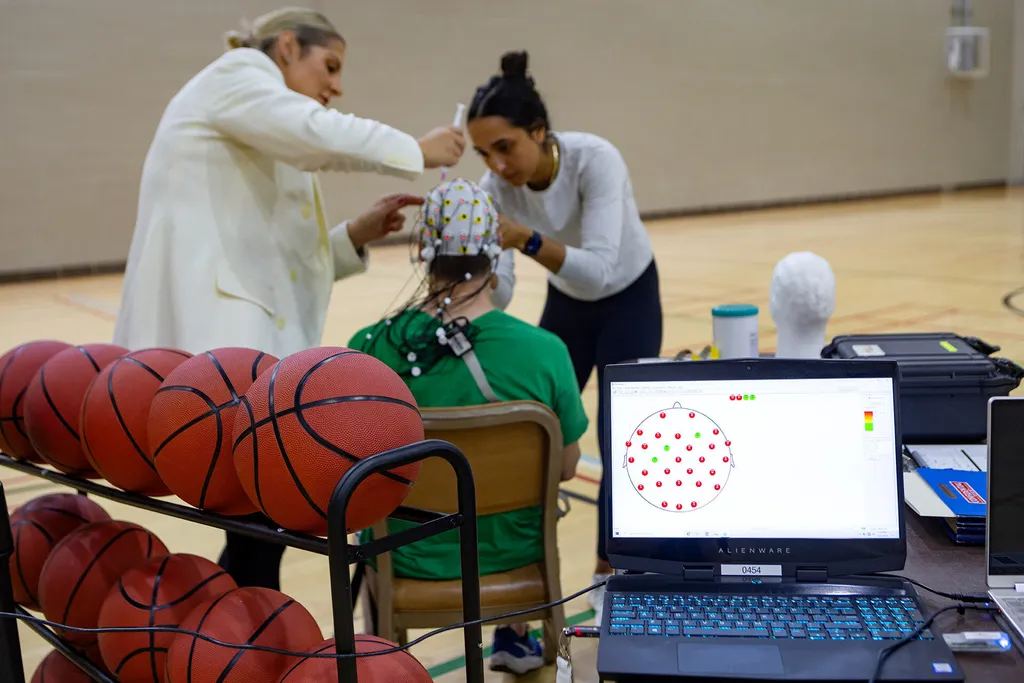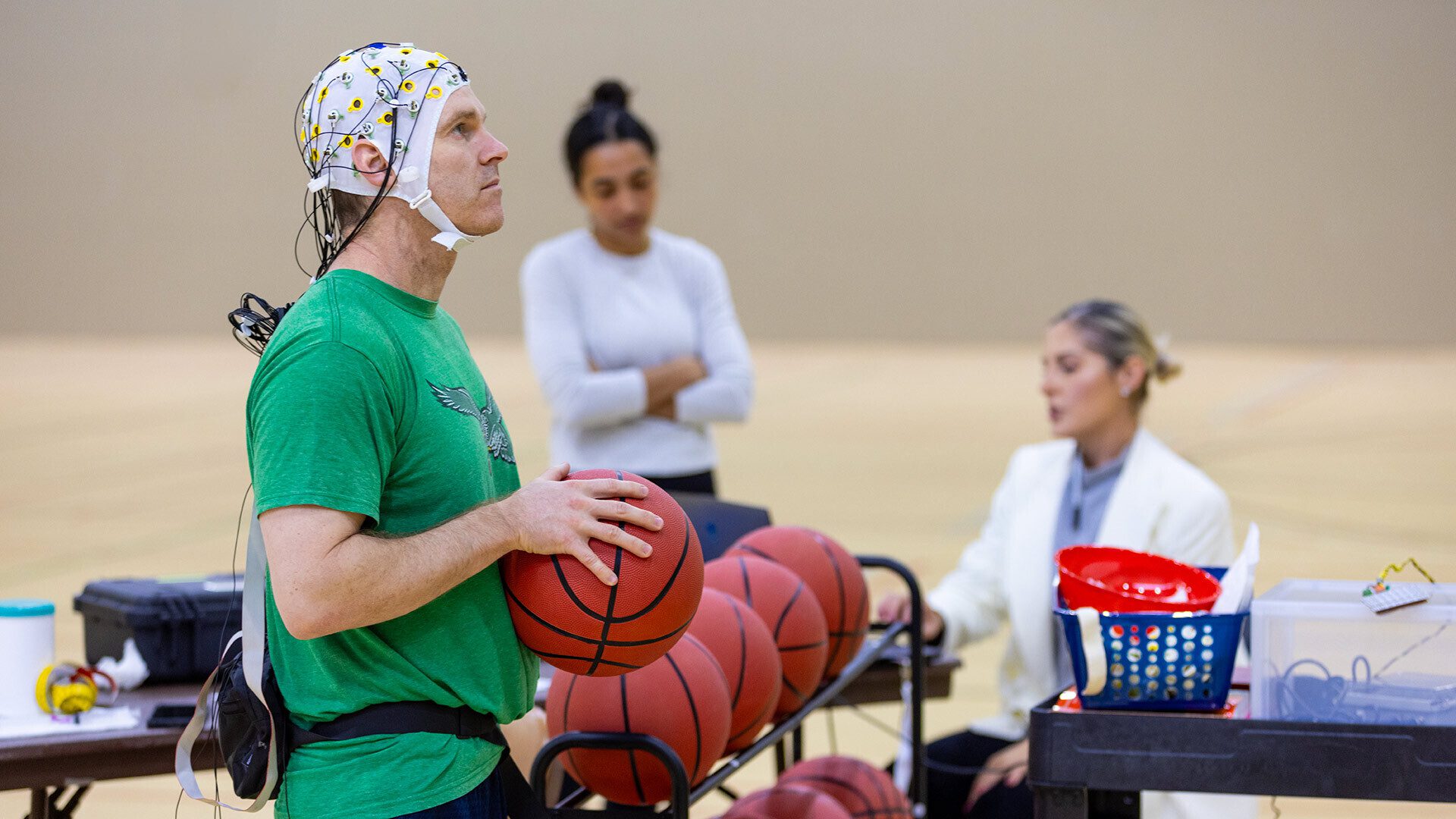- October 24, 2024
- By John Tucker
As I gripped a basketball at the foul line, I tried not to think about the 30 electrodes attached to my skull. I was nervous, but that’s what made me a good subject for a research project now underway in the School of Public Health’s gym.
Kiersten Janjigian, a certified mental performance consultant and fourth-year University of Maryland doctoral student, is leading volunteers in a visualization technique while they shoot two rounds of 25 free throws. It’s previously shown itself to be effective. She wants to know why—hence the equipment she was using to get inside my head.
In her coaching practice, Janjigian incorporates neurofeedback, an increasingly popular tool for elite athletes seeking to elevate their games. Trainers create an environment that mimics competition, jacking up their stress with an upsetting video of them performing poorly, for example. Then they use electroencephalographic (EEG) technology that measures brain activity to reveal areas for improvement, like concentration or relaxation.
“The mental side of training is a really important puzzle piece that connects to physical training,” she said. “It can give athletes that 1% edge.”
Janjigian envisions high schoolers and collegians incorporating neurocognitive training into their regimens, provided it becomes affordable. Among her research questions: What does an athlete’s brain look like under intense stress? On a psychophysiological level, what allows a competitor to shoot, catch or throw better than others?

In her experiment, she’s giving half of the 30 participants instructions on mentally picturing success between their free-throw rounds. The other half, belonging to a control group, read a basketball magazine.
She hypothesizes that the visualization group will perform better in the second round. Once she analyzes the data, she’ll have the model brain activity for sinking shots, which she can use in her coaching practice. What’s more, she’ll have a cognitive roadmap for increasing confidence and decreasing anxiety.
The study relies on well-documented brain science. When an all-star hooper like Steph Curry takes a jumper, his left temporal lobe, the brain’s verbal and analytical chamber, is quiet, Janjigian said. That absence of nonessential activity, called psychomotor refinement, shows that Curry isn’t overthinking.
In contrast, his right temporal lobe, the brain’s visuospatial side, would be more active. That area helps Curry make a quick decision about, for example, his shooting angle.
Things are reversed for a novice athlete, whose left temporal lobe lights up during learning and language tasks. “It feels messy in your head as you talk yourself through it,” Janjigian explained, using a baseball example: “A novice batter steps up to the plate and asks, ‘Is my elbow high enough?’ Experts don’t do that.”
I’m always looking to improve my foul shot, and calming my restless brain felt like a bonus. I signed up for Janjigian’s project.
She and her lab assistant, Rachel Gunter ’26, measured my scalp and covered it with an EEG cap. Next, they affixed the electrodes, coating each one with a gel to amplify the electricity beneath my scalp. The wires led to a fanny pack I wore that sent signals to a computer stationed near the foul line.
My first task was to shoot 10 shots to establish a baseline. (Because I was privy to the study’s methodology and already familiar with visualization techniques, I wasn’t part of the official experiment, so the full round of 25 shots would have been overkill.) A clock instructed me when to grab a ball, when to clear my mind and when to shoot. As I let the balls fly, Janjigian sat behind the computer, observing my brain waves in real time.
During that round, I sank five of 10 shots. Next, I filled out questionnaires asking me to measure things like anxiety (high!), confidence (middling) and overthinking (perpetual).
From there, it was time for the intervention. I sat down and watched a video of Janjigian explaining visualization. For athletes, imagining success translates to on-court success. Next, I closed my eyes as she read a script guiding me through the image of sinking a foul shot.
“Release the ball with the flick of the wrist, the perfect arc carrying it toward the hoop,” she said. “You hear the satisfying swish as it passes cleanly through the net. In this moment you feel unstoppable, like a well-oiled machine.”
When it was time for my second round of shots, I focused on the rim and pictured the ball splashing through the net. I’m a well-oiled machine, I told myself.
After two quick misses, I started overthinking. Then I refocused, quieted my brain and nailed three straight before nerves re-interrupted my flow. In the end, I was five for 10, same as the first round.
As Janjigian removed my EEG cap, she went into coach mode, noting that visualization takes time to master.
“One 15-minute imagery lesson isn’t always going to have immediate effects,” she said.
Maybe not in my shooting rate. But for a few moments when I was in the zone, I was pretty sure my brain waves resembled Steph Curry’s.
Watch Kiersten Janjigian discussing her basketball experiment on the School of Public Health's Instagram page.
Topics
ResearchUnits
School of Public Health